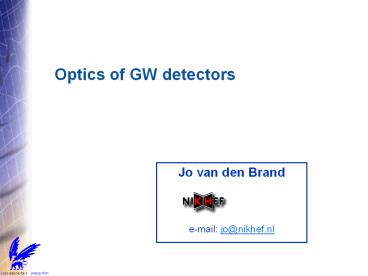Optics of GW detectors - PowerPoint PPT Presentation
Title:
Optics of GW detectors
Description:
Finesse = 50. FSR = 50 kHz. Power. Storage time. Cavity pole ... Simulate with Finesse. Frequency stabilization. Presentation. Control issues. Presentation ... – PowerPoint PPT presentation
Number of Views:24
Avg rating:3.0/5.0
Title: Optics of GW detectors
1
Optics of GW detectors
- Jo van den Brand
- e-mail jo_at_nikhef.nl
2
Introduction
- General ideas
- Cavities
- Reflection locking (Pound-Drever technique)
- Transmission locking (Schnupp asymmetry)
- Paraxial approximation
- Gaussian beams
- Higher-order modes
- Input-mode cleaner
- Mode matching
- Anderson technique for alignment
3
General ideas
- Measure distance between 2 free falling masses
using light - h2DL/L (10-22)
- L 3 km ? DL 10-22 x 106 10-16 (10-3 fm)
- llight 1 mm
- Challenge use light and measure DL/l10-12
- How long can we make the arms?
- GW with f100 Hz ? lGW c/f3x108 km/s / 100 Hz
3000 km - Optimal would be lGW/4 1000 km
- Need to bounce light 1000 km / 3 km 300 times
- How to increase length of arms?
- Use Fabri-Perot cavity (now F50), then
DL/l10-10 - Measure phase shift Df dfx-dfy 4pLBh/le
10.(3 km).200.10-22/10-610-9 rad
L - DL
4
General ideas
- Power needed
- PD measures light intensity
- Amount of power determines precision of phase
measurement Df weDt of incoming wave train
(phase f 2pft) - Measure the phase by averaging the PD intensity
over a long period of time Tperiod GW/2 1/(2f) - Total energy in light beam EI0.1/(2f)hbar.Ngwe
- Due to Poisson distributed arrival times of the
photons we have DNg SqrtNg - Thus, DE DNg .hbar. we and Dt DE
(Df/we).SqrtNg. hbar. we gthbar - We find Df gt 1/ SqrtNg ? Ng gt 1/(Df)2 1018
photons - Power needed I0 Ng. hbar. we .2f 100 W
- Power is obtained through power-recycling mirror
- Operate PD on dark fringe
- Position PR in phase with incoming light
- GW signal goes into PD!
- Laser 5 W, recycling factor 40
5
Cavities
- Fabri-Perot cavity (optical resonator)
- Reflectivity of input mirror -0.96908
- Finesse 50
- FSR 50 kHz
- Power
- Storage time
- Cavity pole
6
Cavity pole
7
Overcoupled cavities (r1 - r2 lt 0)
- On resonance 2kLnp
- Sensitivity to length changes
- Note amplification factor
- Note that amplitude of reflected light is phase
shifted by 90o - Reflected light is mostly unchanged Eref2
- Imagine that dL is varying with frequency fGW
- Loose sensitivity for fGWgtfpole
8
Reflection locking Pound Drever locking
- Dark port intensity goes quadratic with GW phase
shift. - How do we get a linear response?
- Note, that the carrier light gets p phase shift
due to over-coupled cavity. - RFPD sees beats between carrier and sidebands.
- Beats contain information about carrier light in
the cavity - Phase of carrier is sensitive to dL of cavity
9
Reflection locking
Modulation
Demodulation
10
Transmission locking
- Schnupp locking is used to control Michelson
d.o.f. - Make dark port dark and bright port bright
- Not intended to keep cavities in resonance
- Requires that sideband (reference) light comes
out the dark port
11
Gaussian beams
P complex phase q complex beam parameter
12
Higher-order modes
13
Input-mode cleaner
14
Applications Anderson technique
15
Summary
- Some of the optical aspects
- Simulate with Finesse
- Frequency stabilization
- Presentation
- Control issues
- Presentation

